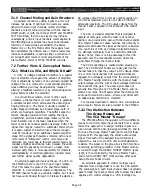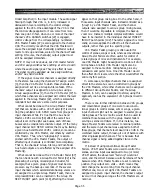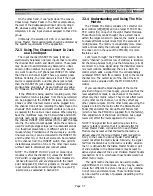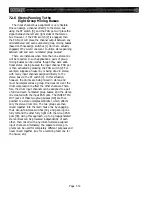
7.1.9 Channel Muting and Gain Structure
As pointed out earlier, adding inputs to a mix will
increase mix levels. If optimum mix levels are estab-
lished with some input channels muted, and those
channels are later turned on (either with the channel
ON/off switch or with the channel MUTE and MASTER
MUTE switches), then the bus levels may increase
unacceptably, and all input channels’ levels applied to
the offending bus or busses may have to be reduced.
Similarly, if some Groups are added to the Stereo
Master mix or the Mix Matrix after those gains have
been calibrated, then Stereo bus or Matrix levels may
increase unacceptably, requiring either a reduction in
all Group Master levels or minor adjustments of the
Stereo Master Fader or MTRX MASTER controls.
7.2 Further Hints & Conceptual Notes
7.2.1 What Is a VCA, and Why Is It Used?
A VCA, or Voltage Controlled Amplifier, is a special
type of amplifier whose gain (the amount of amplifica-
tion) is adjustable by means of an externally applied DC
voltage. This is in contrast to a conventional amplifier,
whose effective gain may be adjusted by means of
altering a feedback resistance or by attenuating audio
signal before or after the amplifier.
In a conventional console, mixer or other audio
processor, a channel fader (or level control) is generally
a variable resistor which attenuates the audio signal
flowing through it. The Fader is usually preceded a
buffer stage and followed by a booster stage, both of
which are fixed gain amplifiers. The buffer keeps the
fader's changing resistance from loading the input
preamplifier, and the booster stage makes up for the
fixed insertion loss of the fader resistance when the
fader is set to its nominal position (typically 6 dB). The
signal then may be routed to a submaster Fader, where
it is again subject to insertion loss so that some gain
must be “made up” by an additional booster amplifier
stage. If the signal path becomes complex, with one or
more levels of “submaster” control, more noise and
distortion can result due to thermal resistor noise and
residual amplifier aberrations. Also, because the audio
signal must be physically routed over a longer, more
involved path, there is more opportunity for crosstalk,
electrostatically or electromagnetically induced noise,
and further signal quality degradation.
An alternate approach involves the use of a VCA. In
the PM4000, there is one VCA in each input module.
That VCA takes the place of the post-Fader booster
amplifier in a conventional console configuration. The
PM4000 channel Fader is a variable resistor, but it does
not have audio flowing through it. Instead, it adjusts a
DC voltage output (from 0 volts at nominal position, to -
0.5 volts at maximum gain, to +10 volts at “infinite”
attenuation position). The DC output voltage from the
channel Fader is applied to the channel's VCA control
input.
The VCA is a special amplifier that is designed to
operate at unity gain when the fader is at nominal
position, can provide some gain with the channel and/or
VCA Master Faders set above nominal, but primarily is
designed to attenuate the signal as the fader is lowered.
(You can think of VCA as Voltage Controlled Attenua-
tor, although technically that is a distinctly different
device.) So far, there is no big advantage to this VCA
approach over the conventional console, where the
audio flows through the channel fader.
The VCA’s advantage is realized when grouping is
used. The VCA Master Faders are really just like the
channel faders in that they output a DC voltage. When
one or more input channel VCA Assign switches are
engaged, the voltage(s) output from the corresponding
VCA Master Fader(s) combine with the channel fader
output voltage, and the sum of these voltages determine
the channel’s VCA gain. The audio signal does not
actually flow through any VCA Master Fader, and no
matter how many VCA Masters affect the channel, the
audio path remains the same... simple and direct with
no added noise, distortion or crosstalk.
For reasons described in Section 7.2.2, conventional
group master Faders are also provided in the PM4000.
7.2.2 The Distinction Between
The Group Busses and
The VCA Master “Groups”
The PM4000 affords the operator with two different
means to control multiple input channels from a single
fader. One approach is to assign multiple inputs to a
given Group with the Group Assign switches [1], and to
then use the Group Master Fader [42] to control those
signals. With this approach, the actual audio output
signal from each of the assigned input channels is
applied to a bus wire via 18K ohm summing/isolation
resistors. The signal on the group bus is then fed into a
combining (summing) amplifier in the Master module,
is routed through the GROUP INSERT IN/OUT jacks
[118], is then controlled by the Group Master Fader,
and is fed to GROUP OUT [130] and any other post-
Group Master Fader circuits.
An alternate approach to control multiple input
channels from a single fader is to use the VCA system.
The audio signal in each input channel does not actually
pass through the channel Fader [25]. Instead, that fader
applies a DC control voltage to a VCA (Voltage Con-
Page 7-4
Summary of Contents for PM4000
Page 1: ...PROFESSIONAL AUDIO MIXING CONSOLE PM4000 OPERATING MANUAL YAMAHA ...
Page 2: ...PM4000 OPERATING MANUAL ...
Page 7: ...Section 1 Introduction ...
Page 11: ...Section 2 Brief Operating Instruction ...
Page 47: ...Section 3 Specifications ...
Page 51: ...Dimensional Drawings PM4000 Console all versions Page 3 4 ...
Page 52: ...Page 3 5 ...
Page 53: ...Page 3 6 PM4000 Console Rear Profiles ...
Page 54: ...Module Block Diagrams See back of the manual for overall system block diagram Page 3 7 ...
Page 55: ...Page 3 8 ...
Page 56: ...Page 3 9 ...
Page 57: ...Page 3 10 ...
Page 58: ...Page 3 11 ...
Page 59: ...Page 3 12 ...
Page 60: ...Section 4 Installation Notes ...
Page 72: ...Figure 4 13 Cables For Use With Balanced Sources Page 4 12 ...
Page 79: ...SECTION 5 Gain Structure and Levels ...
Page 82: ...Figure 5 1 Dynamic Range and Headroom in Sound Systems Page 5 3 ...
Page 86: ...Section 6 Optional Functions ...
Page 106: ...Section 7 Operating Notes and Hints ...
Page 119: ...Section 8 Applications ...
Page 127: ...Section 9 Maintenance ...
Page 131: ......
Page 132: ...YAMAHA VN02300 ...
















































